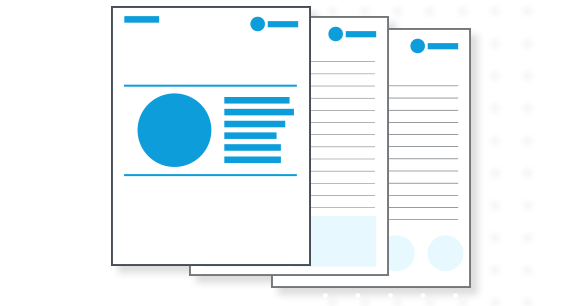Catch up on MuleSoft at Dreamforce. See how our latest innovations supercharge developers and AI agents.
Top 7 trends shaping digital transformation in 2025
AI adoption has exceeded predictions. As we move into a new year, IT leaders and business leaders, alike, are looking to AI and other modern technology to help drive further efficiency and productivity in their organization.
In our new digital trends report, The Top 7 Trends Shaping Digital Transformation in 2025, MuleSoft has made seven predictions for 2025 — enabling leaders to plan ahead and maximize their advantage from AI in 2025.
Read on to learn how will these forces could shape the future vision for your organization.
Trend 1: The autonomous enterprise will take hold. Organizations will continue to augment the human workforce with agents, freeing them to focus on more valuable work.
As organizations’ AI strategies mature, they will shift towards more focused and autonomous models — in some cases that means org-specific models and even Small Language Models (SLMs). Models will power intelligent, autonomous AI agents that operate independently, interacting with existing integrations and automations to enhance productivity and streamline operations. Unlike traditional AI agents, these autonomous agents can handle simple tasks without conversational prompts, reducing the workload for clinicians, software developers, and other professionals.
However, successful integration of these agents hinges on integration. To ensure autonomous agents deliver the correct automated responses, organizations must feed them with relevant data and context.
As autonomous agents mature, they will become a critical component of the modern digital enterprise. Developers must be empowered to integrate these agents seamlessly into applications and workflows, adopting an AI-powered composability approach. This flexible methodology ensures secure, AI-driven experiences with robust governance, enabling agents to connect to the necessary SLMs and data. Ultimately, autonomous AI agents will drive margins and revenue, helping organizations stay resilient against future disruptions.
Trend 2: AI strategies are maturing — it’s autonomous AI agents that will become a critical new building block for fleshing out the strategy.
The adoption of AI has exceeded predictions from last year, and the adoption of AI agents is poised to do the same. As a result, autonomous AI agents will begin to become more involved in automating repetitive and mundane tasks, allowing employees to focus on higher-value, higher-impact work.
This rapid rise in digital agents will lead to the growth of the autonomous digital enterprise, helping to bridge communication between systems and human users. APIs will be essential for enabling these agents to interact with each other and access disparate data sources. Organizations with the most mature API strategies will be best positioned to create a future where humans and agents work in harmony, with technology handling routine tasks and people tackling high-value challenges.
Trend 3: Security and privacy risks will continue to be a top concern. As multi-agent architectures grow, built-in governance guardrails will be critical to mitigate these risks.
As autonomous, multi-agent architectures spread across global enterprises, streamlining workflows, reducing human error, and boosting productivity, organizations will need to implement more robust governance to maintain their security posture.
The growing demand for AI capabilities is likely to worsen API sprawl, where different teams and departments create integrations without centralized management. Already, about a quarter of APIs are ungoverned, and this lack of oversight makes them vulnerable to exploitation.
In the coming year, organizations will prioritize securing their AI agents and associated APIs, ensuring safe connections to data sources and automating processes securely. They will increasingly adopt platforms with built-in guardrails that can mask sensitive data, such as personally identifiable information (PII) and payment card details, before responding to AI prompts from third-party models and autonomous agents.
As these security measures mature, organizations will enable agents to securely incorporate business context from various data sources, adhering to access controls and permissions. Seamless background operations with audit trails will ensure compliance, and with the right platform, security can become a business enabler and accelerator, fostering the innovation promised by the autonomous enterprise.
Trend 4: RPA will evolve to become more autonomous and AI-driven. Generative AI-assisted automation capabilities will increase.
Robotic Process Automation (RPA) has long helped IT teams enhance efficiency, cut operational costs, and reduce manual work. As AI grows, autonomous agents will take on more of the heavy lifting of RPA, such as programming RPA bots. These agents will be trained to understand and autonomously trigger a wide range of processes based on input from orchestration bots, effectively extending the lifespan of legacy systems in the process.
Fully integrated into business operations, these agents will automate a broad spectrum of tasks, including API integration, performance optimization, security monitoring, user interactions, and usage trend analysis. They will also automate code generation, governance policy enforcement, and coordination of enterprise workflows. This evolution will not only enhance their capabilities but also future-proof organizations against technological disruptions.
Trend 5: Existing work structures will be dismantled. AI will continue to change the nature of traditional roles and create new ones in an era of productivity-driven innovation.
AI is revolutionizing businesses by transforming roles and driving productivity. ‘
Developers are among the biggest beneficiaries, with 85% of IT leaders noting increased productivity from AI. Instead of building and connecting APIs manually, they can create reusable assets that autonomous agents can leverage. These agents will discover API capabilities, understand context, and orchestrate solutions, fundamentally altering software development.
In customer service, AI is handling routine tasks through self-service portals and chatbots, allowing human agents to focus on strategic priorities like building customer relationships. Tools like real-time transcription, personalized training, and scheduling support further enhance the agent's role, leading to more meaningful work and improved job satisfaction. This symbiotic relationship between AI and human employees is expected to enhance both the employee and customer experience.
Trend 6: Self-integrating apps will ease innovation bottlenecks. By connecting them with comprehensive and relevant data, AI models will be enhanced.
Integration is crucial for organizations to maximize the value from their application ecosystems, especially when it comes to AI. AI models produce more valuable outputs with accurate, comprehensive, and contextually relevant data. However, despite the push for IT teamsto adopt AI, many IT leaders feel unprepared to harmonize data systems and leverage AI effectively.
To address this, self-integrating apps are gaining traction. Gartner predicted in 2021 that applications would integrate themselves seamlessly, a vision that is now becoming a reality.
These apps promise to alleviate the challenges of custom integration, which often creates an IT bottleneck and hinders digital transformation. Self-integrating apps will enable developers to work more efficiently and cost-effectively, accelerating the transition to an AI-powered autonomous enterprise.
Trend 7: Super apps will offer employees access to a broad range of capabilities from a single interface to improve hybrid workforce productivity.
The world of work is undergoing a permanent transformation, driven by the pandemic, which has accelerated the shift towards flexible working patterns.
As part of this shift, employees are increasingly relying on a growing number of applications. MuleSoft data shows organizations use an average of 991 applications, and this proliferation is unsustainable without full integration, as silos add cost, complexity, and reduce productivity.
In the coming year, organizations will turn to super apps to break down these silos. These composable applications offer access to multiple solutions and features through a single user interface, acting as a platform with core functionalities and an ecosystem of specialized, lightweight apps. Users can customize their super app experiences by adding or removing these apps as needed.




